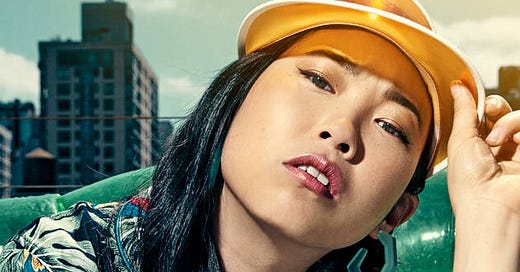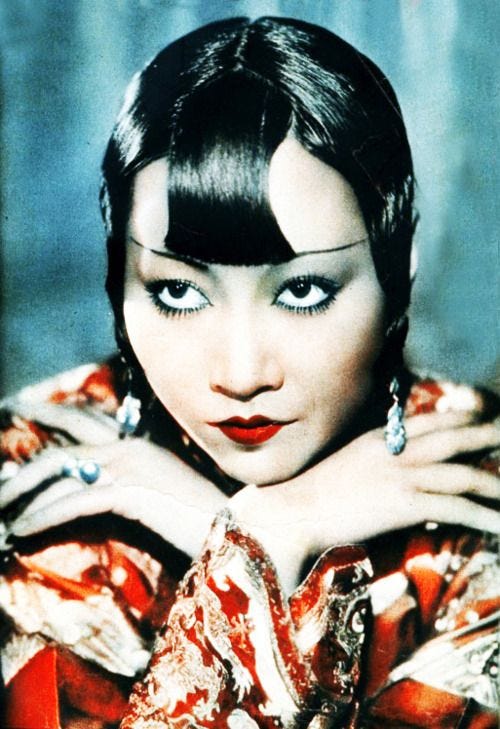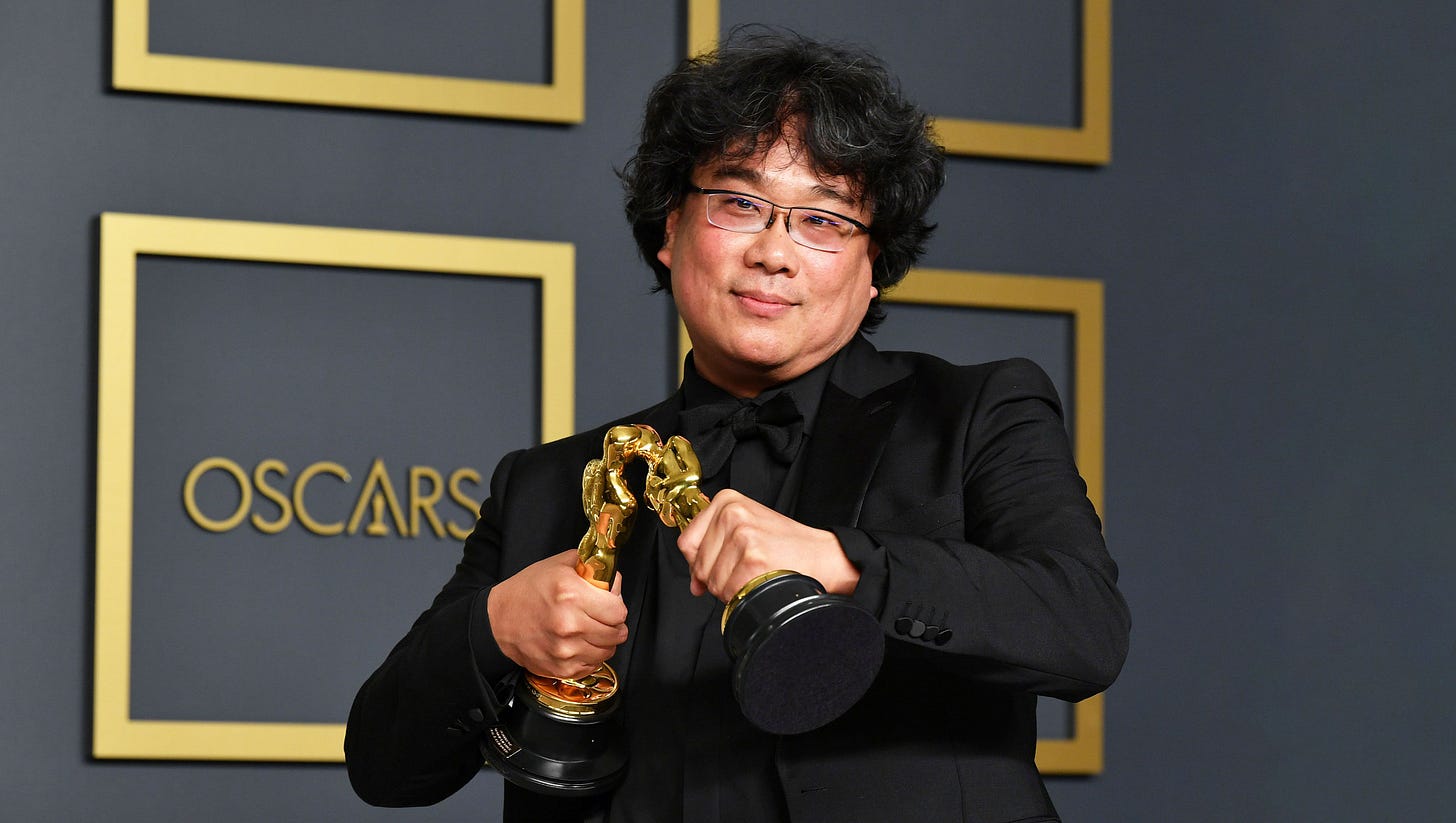It’s AAPI Heritage month, and this year it’s more important than ever to recognize the collective experience of Asian Americans. I’ll be writing posts on Asian American identity and creativity.
Ten years ago, if you asked about a famous Asian American, probably the best most Americans could come up with would be Harold and Kumar. Maybe (1) Amy Tan. (2) Mindy Kaling and (3) Aziz Ansari were just making their mark on primetime sit coms. Asian American music wasn’t a thing, at best an asterisk identity, like (4) Fresh Kid Ice from 2 Live Crew.
In 2021, Asian American creativity has exploded. Asians and Asian Americans boasted seven Oscar nominations and three wins. Asian American comedy is actually a thing, and Mindy Kaling and Aziz Ansari are now showrunners with the clout to make careers. In film, music, and literature (which I cover here), there is a renaissance of Asian American creativity.
And yet 42% of Americans can’t name a single Asian American prominent figure.
(5) Awkwafina says huh?
So let’s talk about Asian American creativity and how we get to prominence.
Let’s start with the movies.
It takes generations to establish a voice that breaks through a dominant culture. For Asian American cinema, it kinda went like this:
Asian American film and video explicitly explored image-making too experimental, too queer, too resistant to labels to comfortably assemble into a neat corpus.
However, following the so-called “Class of 1997” when an unprecedented number of feature films premiered at the San Francisco International Asian American Film Festival, a wave of self-consciously Asian American films with an eye on national audiences burst onto the scene…Whereas an earlier generation of sporadic feature filmmaking ( (6) Wayne Wang’s Chan Is Missing in 1982, (7) Mira Nair’s Mississippi Masala in 1991, (8) Ang Lee’s The Wedding Banquet in 1993) found audiences primarily in the mainstream art house circuit, this later wave of films fed a nationwide hunger of Asian Americans to see themselves reflected on-screen and on their own terms.
Funny & fighting
Like many minority culture knocking on the door of the mainstream, comedy is the path. Harold and Kumar Go to White Castle hit the mainstream before weed was legal, and then Kumar ( (9) Kal Penn) went on to advise the Obama administration while Harold ( (10) John Cho) continued to build his acting and directing profile.
(11) Eddie Huang’s Fresh off the Boat, modeled the familiar family sit com through an Asian immigrant lens, and launched the careers of (12) Constance Wu, (13) Randy Park, and (14) Ali Wong. Soon, every workplace sitcom needed an Asian American character undermining stereotypes, from Aziz Ansari’s hustler on Parks and Rec to (15) Vincent Rodriguez as handsome Filipino crush on Crazy Ex-Girlfriend to (16) Charlotte Nicdao and (17) Danny Pudi on Apple+’s Mythic Quest. (18) Lily Singh sprung from a YouTube sensation to hosting Late Night on CBS. And Awkwafina supernova’ed from loud-mouthed rapper to movie star to it girl and show runner.
Unlike most minority cultures, Asian American cinema has a unique entry point: the action flick. Born of the kung fu movies of yore, the legacy of (19) Bruce Lee and martial arts films leapt the Pacific, with (20) Jackie Chan taking up the mantle. (21) Ang Lee can magically direct everything from Crouching Tiger, Hidden Dragon to Remains of the Day to the fricking Hulk. And “Class of 1997” graduate (22) Justin Lin went on to create the “post-race” fantasy franchise Fast and Furious.
(21) Sang Kung as the heart throb Han in the Fast and Furious franchise
In the meanwhile, (23) John M. Chu’s Crazy Rich Asians, starring an Asian cast including Wu, (24) Henry Golding, goddess-level (25) Michelle Yeoh, and based on (26) Kevin Kwan’s hit novel, proved to Hollywood that Asian American stories can win at the box office. That movie is a quintessentially American story, of someone caught between two cultures, wide-eyed at a world more sophisticated than she dreamed. But so is The Farewell, (27) Lulu Wang’s lovely tale of a young woman, played by Awkwafina, going back to her motherland to say goodbye to a dying grandma. Both of these films made splashes and made money in the US, but failed in China. Because these are not Asian stories, they’re Asian American stories, and even more so, because Asian Americans are hungry to see their stories on screen.
Like I wrote about last week, there is no singular Asian American experience. So it’s a thing of beauty to see a film like (28) Lee Isaac Chung’s Minari, starring (29) Steve Yuen, (30) Han Re-Yi, Oscar-winning (31) Youn Yuh-jung, and heart-stealing (32) Alan S. Kim about Korean immigrants, lined up in the Oscars next to a film like Sound of Metal, about a deaf drummer in a noise band who just happens to be Pakistani-English actor (33) Riz Ahmed, and of course, a story about the fringes of American society told by (34) Chloe Zhao, Chinese director educated in the US.
Beyond the real world,(35) Kelly Marie Tran starred in Star Wars, and (36) Simu Liu will be the first Asian lead in the Marvel universe. Recently (37) Dev Patel was trending on Twitter for his role in the new A24 fantasy film The Green Knight. Love it or hate it, Mortal Kombat starred a bunch of Asian and Asian American martial artists like (38) Lewis Tan and (39) Joe Taslim.
Dev Patel in The Green Knight
Now let’s talk a little about music.
Because the movie stars weren’t the only ones holding gold.
H.E.R. (Getty)
Black Filipino artist (40) H.E.R. won an Oscar for her song, Fight For You. She, (41) Bruno Mars, and (42) Anderson.Paak have won Grammys, and are building an unexpectedly rich canon of music that draw on their multi-racial experience. Awkwafina launched her career in rap, as did Riz Ahmed. There’s a wave of young R&B artists of Asian descent, like (43) Audrey Nuna (obsessed), (44) Joji, and (45) Jhene Aiko.
Audrey Nuna (photo by @khufunajee)
In creativity, borders and identities are fluid, and Asian American culture is inspired and bolstered by what happens in the motherland and in the diaspora, so my definition of “Asian American” has been pretty loose here. After the 1998 financial crisis, the South Korean government’s macro-economic policy included cultural exports invested in culture, including film, television, and music, leading to last year’s double Oscar win for Parasite director (46) Bong Joon-Ho, and the global dominance of Korean bands like (47-53) BTS and (54-57) BlackPink. Bollywood produces more movies than Hollywood, and the South Asian diaspora has spread dance music like Bhangra to clubs in NY and LA through DJs like (58) DJ Rekha. (59) M.I.A. is a global south phenomenon, spanning the globe from Sri Lanka to London to the Super Bowl. (60) Rich Brian is an Indonesian rapper who crossed over to the US. (61) Priyanka Chopra won Miss World and was already a legend in India before landing in the US and into celeb-royalty when she married a Jonas brother. With a major part of the South Asian diaspora coming through the UK, Dev Patel and Riz Ahmed came through the UK, along with (62) Jameela Jamil from The Good Place, and (63) Zayn Malik from One Direction.
M.I.A.
The Oscars are not the end-all be-all of American cinema; they will overlook greatness and disappoint us over and over again, but they are a measure of mainstream acceptance that has passed over Asian American talent since their inception. If the newer school of Asian celebrity isn’t familiar, there’s a long history of pioneers (64) Margaret Cho, (65) Sandra Oh, (66) Lucy Liu, (67) Ben Kingsley, (68) George Takei, (69) Pat Morita, and the very first, (70) Anna May Wong.
Anna May Wong
And the cultural world of film and music isn’t the only contributor to American culture; there’s a whole world of creators on TikTok and Instagram, and of course, our most prominent Asian American is in the White House, VP (71) Kamala Harris. Not to mention other break-out Asian American politicians like (72) Angela Duckworth, (73) Andrew Yang, (74) Mazie Hirono, and, yes, even (75) Nikki Haley.
Making out with Bong Joon-Ho
So here’s to 2021, the year Asian American creativity gets on the map.
Next episode? Let’s talk about Asian Americans and creativity in food.
Fun Facts
Directors Lulu Wang of The Farewell and Barry Jenkins of Moonlight & Underground Railroad are partners and live together in this cute Silver Lake abode.
For you ad folks out there, Ad Age is doing a great section on AAPI people & projects in the ad world.
Good for Good Morning America, who put together an endless, mind-blowing list of Asian American creativity that shows the deliciously rich web of connections it takes to build a voice in culture.
I’m a fan of South Asian mag The Juggernaut, a model for a modern diasporic media.











